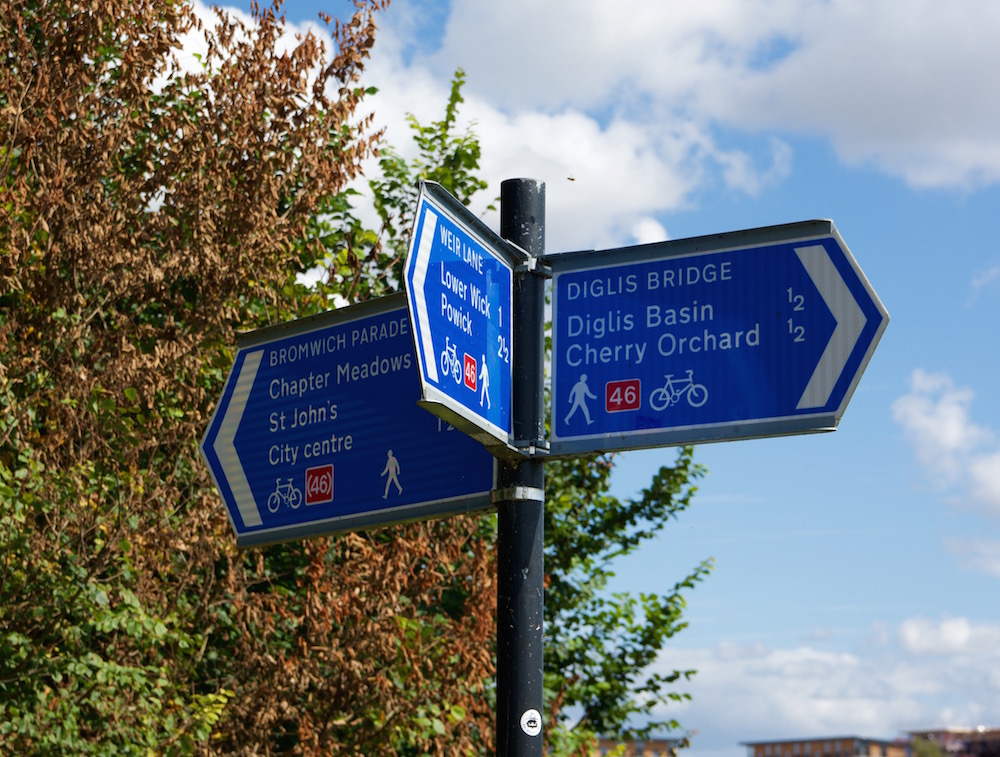
Diglis Bridge is a shared use bridge over the river Severn in Worcester, built to increase connectivity for pedestrians and cycle users in the south of Worcester. There was a rumour I heard that Diglis Bridge was the one piece of cycle infrastructure in the West Midlands to go forward for an award for high quality cycle infrastructure this year (2015), I decided to head over and have a look at it. It seems that I was mistaken, but I had a good day out anyway, and believe that Diglis Bridge is a great piece of infrastructure regardless.
Diglis Bridge was built through a Sustrans' led project, who have an article about it on their website. What strikes me most about the article is that surveys before the bridge was built estimated the number of trips that would use the bridge each year as 31,000, but repeated surveys afterwards have shown the actual figure to be over 450,000 trips each year. Infrastructure projects are evaluated on the benefits that it is believed they will bring, and when the estimates for those benefits are out by a factor of 10, it could easily lead to projects being rejected that would have brought great benefit to their local communities.
So, what is all the fuss about? Why do I think this bridge is so great?
- Links: Diglis Bridge lies at the half-way point between the only road bridge at the centre of Worcester and the road bridge on the Worcester ring road, and is the only bridge across the River Severn in that space. As the bridge is only for cycle and pedestrian traffic, it has created a link between the areas either side of the river that is faster to use than driving a car. The shared use cycle routes from the bridge have been well planned to provide good links to the local areas, making accessing the bridge easy and simple. Making cycling faster for short journeys than driving a car is essential for promoting a higher cycle modal share, and the Diglis Bridge achieves that well.
- Width: Diglis Bridge is much wider than the shared-use green route bridges that Birmingham City Council has built recently with Birmingham Cycle Revolution funds. I estimate that you could fit 4 cycle users side-by-side going across this bridge with ease. This sort of width is essential to ensuring maximum comfort for both cycle users and pedestrians, and meets the requirement that this bridge is not simply a leisure facility but is a serious piece of transport network infrastructure. The connecting routes are all also have a good width, with the shared-use routes being close to 3 meters, wide enough for cycle users to overtake pedestrians without conflict. This is also in contrast to the recent greenway routes in Birmingham, where BCC has insisted on building shared-use routes no more than 2 meters wide, with the result that it is difficult for cycle users to pass pedestrians without the pedestrians stopping.
- Bollards and barriers: Specifically, there are no access barriers to these routes, but only plastic bollards to stop motor vehicles. BCC has installed tight gates on many of the new cycle routes built through the Birmingham Cycle Revolution, which make it difficult for recumbents, trikes and cargo bikes to access the new infrastructure. Worcester, however, has mainly used bollards sparingly on their cycle routes, resulting in increased ease of access for all cycle users.
- Lighting: Providing lighting on green routes is important for social safety, so that the infrastructure can be used all year around. The majority of the new green routes connecting with Diglis Bridge had lighting installed to provide that sense of safety. BCC have not yet installed any lighting on the green routes and canal towpaths, although they are planning on looking at energy-efficient lighting trials on a couple of routes. I hope that those are successful and that they roll out the lighting across the rest of the green network.
- Attention to detail: On the Diglis Bridge, there are pedestrian steps to reduce the distance people have to walk if they approach the bridge from the back. On most bridges, these steps are open, with the risk that an inattentive cycle user might go flying down them, but on Diglis Bridge, there is a barrier built into the design of the bridge which makes this impossible, while not inconveniencing pedestrians. This is a feature that would be good standard practice on future bridges.
- Signage: There is comprehensive signage around Diglis Bridge, both showing the routes from the bridge to other locations and also showing the route to the bridge from the surrounding locations. There appears to be no chance of missing the connecting routes, helping local people to make use of this facility.
It isn't very surprising that Worcester has done so well with this bridge, as there is an older cycle and pedestrian bridge crossing the River Severn next to the racecourse. That bridge (which I've been unable to find the name of) is not as wide as Diglis Bridge, although it is still wider than than the bridges being built in Birmingham, and fulfils the same function as Diglis Bridge, joining the two sides of the river. It also has good links to connect routes to it, and uses bollards rather than barriers to prevent motor vehicle access. Doubtlessly, Worcester learnt from comments about that bridge when they were building Diglis Bridge.
Diglis Bridge and the Malvern Hills

Diglis Bridge cycle users 1

Diglis Bridge pedestrians

Diglis Bridge cycle users 2

Diglis Bridge stairs

Diglis Bridge sign 1

Sign pointing to Diglis Bridge

Access lane to Diglis Bridge

Access lane to Diglis Bridge 2

Greenway river side path in Worcester

Worcester bollards

Worcester bollards 2

Old shared use bridge in Worcester

Road crossing in Worcester



